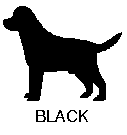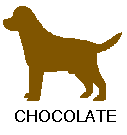If you don't mind me jumping in!
This is a pretty diagram that shows what dogs that appear to be a particular color can carry as a recessive.
FIGURE 1.
 =
= or
or or
or or
or
 =
= or
or or
or
 =
= or
or
Snagged from Wing-N-Wave Labradors Genetics
Posted on 02/26/2005 12:42:26 PM PST by Cagey
For the 15th year in a row, the Labrador retriever is America’s favorite purebred, according to registration numbers tallied by the American Kennel Club.
The AKC released the figures and, as in past years, the Labrador far outstrips the second-most favorite – the golden retriever. For 2004, all the same breeds made the top 10, but four breeds switched positions. The German shepherd moved into third place, switching positions with the Beagle, and the Yorkshire terriers moved into fifth place, taking the Dachshund’s spot.
The Top 10 Breeds of 2004 are:
1. Labrador retrievers 149,692
2. Golden retrievers 52,550
3. German shepherds 46,046
4. Beagles 44,555
5. Yorkshire terriers 43,522
6. Dachshunds 40,770 7. Boxers 37,741
8. Poodles 32,671
9. Shih Tzus 28,958
10. Chihuahuas 24,850
At the other end of the spectrum, the English foxhound is again the least-registered purebred dog with 17 registrations followed by the otterhound 23, American Foxhound 42, Sussex Spaniel 45 and Harrier with 53 registrations.
Top Dogs in England
The United Kennel Club (UKC) also released their national statistics recently, which show that the Labrador Retriever also reigns in England. The lab is followed by the Cocker Spaniel and the English Springer Spaniel.
The top 10 dogs in England are:
1. Labrador Retriever
2. Cocker Spaniel (English)
3. English Springer Spaniel
4. German Shepherd Dog
5. Staffordshire Bull Terrier
6. Cavalier King Charles Spaniel
7. Golden Retriever
8. West Highland White Terrier
9. Boxer
10. Border Terrier
AKC Categories
The AKC recognizes dogs in seven categories: sporting, hound, working, terrier, toy, non-sporting and herding. The largest breed registration in each group is as follows:
# Sporting – e.g. Labrador retriever
# Hound – e.g. beagle
# Working – e.g. boxers
# Terrier – e.g. miniature schnauzer
# Toy – e.g. Yorkshire terrier
# Non-sporting – e.g. poodles
# Herding – e.g. German shepherd
In 2004, the AKC registered 153 different breeds, including the newly recognized Black Russian Terrier, Glen of Imaal Terrier and Neapolitan Mastiff, for a total of nearly one million dogs (958,272) and 437,437 litters.
I just don't want to end up with more dog than I can handle, I guess. :') I don't have much experience with larger dogs. The heeler mix was around 30 lbs, and my last dog was a chihuahua. I don't want to be one of those people that gets a large breed, then dumps it in a few weeks because they can't handle it.
From my experience, size isn't the biggest factor with how hard to train or handle a dog is... some of the larger breeds are actually more laid back than some of the smaller ones. Your Aussie example or a Border needs a lot more attention than many labs, and many goldens are so mellow you have to try to get them to get up and go. I had a tough lab, and he was only hard because he was thinking sex all the time, neuter him earlier, and he would have been a dream. If you want an easy temperament, try a golden from show lines (field dogs will by higher drive) I showed a lot in obedience, and Goldens seemed to come out of the box trained and obedient. Heh.. I used to sortof look down my nose at them, and the Sheltie people since they never had to work on it at all...
Again, you can get a feel from the parents how 'intense' they are, and how 'hyper' they are.
Bubba, the black lab has strict requirements for approaching people.
If they are walking toward him, they want to pet him.
If they are walking away from him, they want to pet him, but have somehow gotten turned around.
If they smile at him, they want to pet him.
If they cringe away, they want to pet him, but are just shy.
As a man we met remarked, "That's a big dog, but he has a puppy brain."
You are smart to worry. Bubba weighs 96 pounds and is strong as an ox.
He's pretty well mannered, but if he really decides to go somewhere, he could pull me down and I'm rather small. I use a prong collar which slows him down (a little).
Just be sure he's well-trained and you'd probably be okay.
Can I get on that list?
Yup!
"They have older dogs that are terrific!"
AH! And no puppy mania, what a great idea. I'm not a dog person, but I think hubby would love to have one, even though he won't admit it. Not now, but maybe someday. I know it would really be my responsibility, so I'll remember your suggestion!
If you're interested in a special breed, try the rescue societies for that breed.
We got Bubba from a lab rescue group.
One nice thing about it is that these dogs have all been fostered and the foster parents will tell you truthfully all the goods and bads. They won't try to gloss over any faults, because they want to place the dogs where they won't be returned.
Lab ping for xs. Miss Hair's an expert, so I pinged you to her size description. There are a few pictures scattered about, and an interesting list of favourites in the article(including Loosh's breed [Cav]).
If beagles are so popular at #4, where the heck are they? In my 50 years I don't think I've seen more than half a dozen.
Bah, there are a couple of lists, the Cavs are in the one from England.
Thanks, that's very interesting. Now, a quick question. What about mixed litters where there are yellow, chocolate and black labs in the same litter even if both parents are say, black labs. How does that happen? I've always wondered.
Many rabbit hunters have beagles and usually, they have more than one. I've never hunted rabbits but friends who have with beagles say that it's a great sport to be involved in. They say just watching the beagles work is a blast.
There are some of those really big dogs out there... especially in field lines. Not sure why they want to breed such a big dog, the purpose of the Labrador was to be short coupled dog, compact enough that you could fit him in your duck boat, and help him back in after a retrieve! Ah well.. The breed standard is still the same, and finding one with parents within this range should not be difficult if size is an issue.
Size, Proportion and Substance Size--The height at the withers for a dog is 22½ to 24½ inches; for a bitch is 21½ to 23½ inches. Any variance greater than ½ inch above or below these heights is a disqualification. Approximate weight of dogs and bitches in working condition: dogs 65 to 80 pounds; bitches 55 to 70 pounds. (American Kennel Club - Labrador Retriever)
I would consider a small Lab. Look at my post 33 - and look how short Dozer (the Black Lab) is standing against Patti's knees. If he didn't have all that show fat on, he wouldn't weigh much more than my girl.
Shelley is 20 1/2 inches at the shoulder, or 21 1/4 (depending on whether she was measured by a USDAA or an AKC judge!) and she weighs exactly 47 pounds as of last Friday. She is as tough as nails, has great endurance, and although she has that hot field trial temperament, she's very biddable and obedient. For example, she never pulls on a leash, ever (well, unless a squirrel runs by right under her nose).
I know some field trial dogs that are on the small size (Shelley's good friend Tori weighs 55 pounds and is no taller than Shelley - the difference in weight is due to her longer back (another field trial trait)) but your best bet for a small Labrador is to get a show dog with English breeding predominant (the English Labs are smaller than the American Labs) -- and don't over feed the dog!!!.
There are field trial Golden Retrievers that are small like Shelley - the show Goldens tend to be huge big dogs. Of course the show Goldens are the mellow ones. I thought about a Golden but couldn't deal with all the hair and the constant shedding.
Shelley won't approach someone until they look at her - but once they do, they better brace themselves . . . she never met a stranger.
Here's the basic idea: there are really only TWO colors of Labrador - Black and Chocolate. That's the color they are underneath, i.e. their skin. Chocolate is recessive, so a Black Lab can carry a Chocolate gene.
Yellow Labs result when the gene for pigment in the coat color is absent. There are two possible kinds of Yellow Labs - a Black Lab with a yellow coat, and a Chocolate Lab with a yellow coat. The Yellow Labs with chocolate skin are known as "Dudleys" - those are the ones with pink noses. They are barred from the show ring and breeders try to avoid breeding them (another reason why the Choc gene pool is more restricted). The gene for yellow coat pigment is also recessive.
So Dozer (whose dad was a Yellow Lab) may give the black skin or the chocolate skin to his offspring, and he may also give the gene for a yellow coat. When he was bred to a Chocolate, Shelley's mom, all nine of the pups were either black or chocolate - no yellows. If he were bred to a proper (black skinned) yellow Lab, there wouldn't be any Dudleys (but the pups would have the possibility of carrying one copy of the chocolate gene). If he were bred to a bitch with a chocolate gene AND a yellow gene, you would have the possibility of all three colors in the litter (and of a Dudley or two).
Occasionally you can have a yellow-to-yellow mating (which should produce all yellows) with a black pup cropping up. It's pretty rare, and some theorize that some yellow Labs aren't "really" yellow, but are carrying a secondary gene that may be expressed as black. More than you ever wanted to read about coat color in Labs
I can work the permutations for Siamese cats in my head, because (a) I bred them for 15 years and (b) there are only TWO combinations in the classic Siamese colors - (1) Blue or Seal; (2) Dilute factor, which gives Lilac or Chocolate. But the third factor in the Labs means that I would have to work out the probabilities on paper! Argh!
If you don't mind me jumping in!
This is a pretty diagram that shows what dogs that appear to be a particular color can carry as a recessive.
 =
= or
or or
or or
or
 =
= or
or or
or
 =
= or
or
Snagged from Wing-N-Wave Labradors Genetics
No wonder I couldn't do it in my head! (Siamese are much easier!)
Disclaimer: Opinions posted on Free Republic are those of the individual posters and do not necessarily represent the opinion of Free Republic or its management. All materials posted herein are protected by copyright law and the exemption for fair use of copyrighted works.